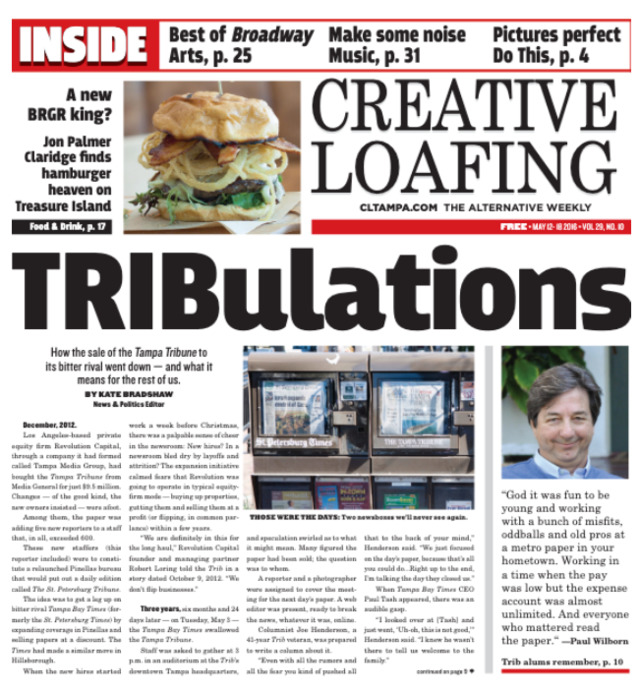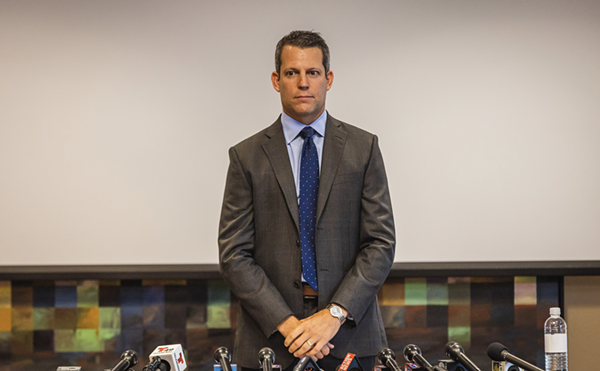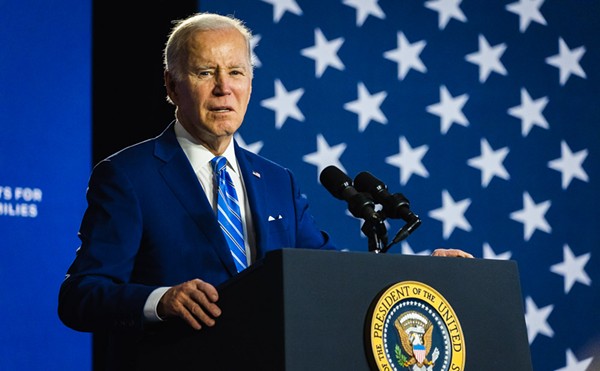December, 2012.
Los Angeles-based private equity firm Revolution Capital, through a company it had formed called Tampa Media Group, had bought the Tampa Tribune from Media General for just $9.5 million. Changes — of the good kind, the new owners insisted — were afoot.
Among them, the paper was adding five new reporters to a staff that, in all, exceeded 600.
These new staffers (this reporter included) were to constitute a relaunched Pinellas bureau that would put out a daily edition called The St. Petersburg Tribune.
The idea was to get a leg up on bitter rival Tampa Bay Times (formerly the St. Petersburg Times) by expanding coverage in Pinellas and selling papers at a discount. The Times had made a similar move in Hillsborough.
When the new hires started work a week before Christmas, there was a palpable sense of cheer in the newsroom: New hires? In a newsroom bled dry by layoffs and attrition? The expansion initiative calmed fears that Revolution was going to operate in typical equity-firm mode — buying up properties, gutting them and selling them at a profit (or flipping, in common parlance) within a few years.
“We are definitely in this for the long haul,” Revolution Capital founder and managing partner Robert Loring told the Trib in a story dated October 9, 2012. “We don’t flip businesses.”
Three years, six months and 24 days later — on Tuesday, May 3 — the Tampa Bay Times swallowed the Tampa Tribune.
Staff was asked to gather at 3 p.m. in an auditorium at the Trib’s downtown Tampa headquarters, and speculation swirled as to what it might mean. Many figured the paper had been sold; the question was to whom.
A reporter and a photographer were assigned to cover the meeting for the next day’s paper. A web editor was present, ready to break the news, whatever it was, online.
Columnist Joe Henderson, a 41-year Trib veteran, was prepared to write a column about it.
“Even with all the rumors and all the fear you kind of pushed all that to the back of your mind,” Henderson said. “We just focused on the day’s paper, because that’s all you could do...Right up to the end, I’m talking the day they closed us.”
When Tampa Bay Times CEO Paul Tash appeared, there was an audible gasp.
“I looked over at [Tash] and just went, ‘Uh-oh, this is not good,’” Henderson said. “I knew he wasn’t there to tell us welcome to the family.”
Department heads got the news of the purchase only 15 minutes ahead of the rest of the staff. They, too, had been called into a meeting for an unspecified purpose.
“We were sort of anxious, but part of us was kind of excited,” said then-Trib managing editor Ken Koehn.
And then in walked Tash and Times editor and vice president Neil Brown. Koehn said his heart sunk, and a woman sobbed.
Dozens would lose their jobs. (While the Times initially announced it would lay off 100 or so employees, an internal memo initially reported on by the Tampa Bay Business Journal suggests that only a few dozen will be permanently kept on staff.) There would be no Tribune tomorrow, no final edition in which editorial staff, many of whom have been there for decades, could say goodbye.
“Whether we were to close or not, we really kind of wanted to speak,” Koehn said. “It was like going out without saying goodbye to our readers. It was kind of sad.”
He said he could see why, though, given that the Times would be inheriting thousands of subscribers. Receiving a farewell issue from the Trib one day and a Times the next might not be good for business.
Same went for tbo.com, one of the first news websites in the region, which went live in 1994. Site traffic was temporarily rerouted to tampabay.com, the Times’s website shortly after the announcement.
A local media pillar over 120 years in the making — its brand, its culture, its people — was gone, like that.
It’s not like bad news was unexpected.
Even after the purchase, there were periodic rounds of furloughs, pay cuts and layoffs. The St. Petersburg Tribune bureau was shuttered in late 2014. Last summer, Revolution sold the riverfront building that housed the paper to a Miami developer for $17.75 million. In February, the Times signed a five-year contract to print the Tribune. Decades-old rumors of a possible merger or sale again gained steam, but when WTSP/Channel 10 investigative reporter Noah Pransky asked Loring and Tash about it in mid-April, they brushed off the rumors as “bs” and “speculation,” respectively.
(However, the Times reported on May 3 that the contract to print the Trib and the contract to buy it “were signed at the same time.”)
For at least two years, Trib managers say, accounts payable had fallen behind on freelancer and contributor invoices. Execs were supposedly looking for new headquarters — even, reportedly, bringing in IT staff to scope out the tech logistics — but time was rapidly running out.
“The publisher [Brian Burns], who everybody likes, had been working hard to find office space,” Koehn said. “It was a little disheartening to find out all that effort was pointless in the end.”
Even though it wasn’t entirely surprising, the news hit the journalism community, even those associated with the competition, hard.
“What [Revolution] did was shameful,” said USF-St. Pete professor of journalism Rob Hooker, a 40-year Times veteran and the paper’s historian, who was laid off in 2011. “They gutted the newspaper, which went from 618 employees to, well, probably a hundred of them will probably stay with the Times, and that’s in four years...That’s what equity investment companies do. They buy companies, they harvest the good stuff, then they flip it and leave.”
But Revolution’s Robert Loring at least seemed to be making plans to stick around: Property records show that he bought a $1.8 million home (complete with wine room and billiards room) off Tampa’s opulent Bayshore Boulevard in September of 2015.
As Tash made his announcement May 3, Trib employees said they could see people walking into the building carrying boxes. At some point, everyone was divided into groups, first by department, then by status — the few who were being kept on permanently as Times staff, those who would be kept on for a “transitional” period, and those whose employment ended then and there.
They were sent upstairs to the newsroom to gather their belongings. Some had already packed up, given the supposedly impending move.
There was confusion over whether those who’d been laid off would be allowed to keep their company-issued model 4S iPhones, and it was ultimately decided that they could — but all contacts, emails and apps would be cleared. Some wanted to keep their old phone numbers for personal use, but a trail of unpaid company phone bills made dealing with Verizon representatives a challenge, former staffers said.
They were given thumb drives to collect personal files from their work computers, but weren’t allowed to download their Outlook contact lists, which included sources as well as family members.
The whole time, according to staffers, they were being watched.
For their part, the Times was generous with severance packages to those laid off — 60 days’ pay and benefits — and gracious as Tuesday’s events unfolded.
“The Times was businesslike and compassionate at the same time,” Henderson said.
Tash told the Columbia Journalism Review days after the closure why, even though a select few had known about the purchase for months, it happened in a flash.
“I’ve been involved in long goodbyes and short goodbyes in my life, and the long goodbyes are always more difficult,” he told the Review’s Susannah Nesmith.
CL asked for a comment from Tash on Thursday, May 5, and, at the request of a spokesperson, emailed questions to her on Friday. She told us this week that Tash would be unable to speak with CL in time for our print deadline, which was Tuesday at 11 a.m. Calls for comment to the Revolution Capital PR department on Monday and Tuesday of this week were not returned.
With the disappearance of the Trib, the Tampa Bay market became a region with only one daily newspaper.
Tash said in a column that absorbing its biggest rival would ultimately benefit the region; that not having to compete with the Trib for eyeballs and advertisers would put the Times on “solid financial footing,” thus enabling it to invest more resources in its newsroom. This, despite the fact that the Times, not in the most financially stable position itself, borrowed $13.3 million to finance the purchase of the Trib, the paper itself reported May 4.
He noted that very few metro areas are able to sustain two newspapers these days, and Tampa Bay is no longer one of them.
“Unfortunately, they were right,” Henderson said. “The market’s only big enough for one newspaper, and it wasn’t us.”
The challenges the Times and the Trib have contended with in recent decades — lagging print ad revenue, an almost-unlimited flow of free web content, and what seems to be a dramatically diminished interest in news and public affairs among the general public — means most media outlets across the country have taken hits.
But being a one-daily region has its obvious drawbacks, media experts say, when it comes to newspapers’ number-one priority: protecting the public interest.
“When you have two newspapers fighting for the same market, there can be no complacency,” said Rob Hooker, the USF journalism professor and Times veteran. “Each paper makes the other better just by being there. It means you’ve got two skeptical reporters at City Hall rather than one.”



















